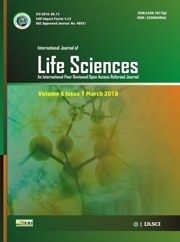Research Article
Volume 8 |Issue 6| November-December 2020 First published: 31 December 2020
Macro Invertebrate Diversity of Adan Dam, Karnja, Washim, MS, India
Tantarpale SA
Bhagwantrao Arts, & Science College, Etapalli, Dist. Gadchiroli, ( M. S.)
Email: tantarpale.swati123@gmail.cp>
Abstract
Keywords:Adan Dam, Macro Invertebrate Diversity.
Cite this article as:
Tantarpale SA. Macro Invertebrate Diversity of Adan Dam, Karnja, Washim, MS, India, Int. Res. Journal of Science & Engineering, 2020, Volume 8(6): 263-266.
Copyright:
Open Access This article is licensed under a Creative Commons Attribution 4.0 International License, which permits use, sharing, adaptation, distribution and reproduction in any medium or format, as long as you give appropriate credit to the original author() and the source, provide a link to the Creative Commons license, and indicate if changes were made. The images or other third party material in this article are included in the article’s Creative Commons license, unless indicated otherwise in a credit line to the material. If material is not included in the article’s Creative Commons license and your intended use is not permitted by statutory regulation or exceeds the permitted use, you will need to obtain permission directly from the copyright holder. To view a copy of this license, visit http://creativecommons.org/ licenses/by/4.0/
References
1. Belsare DK and Oommachan L. Preliminary note on the benthic fauna of lower lake of Bhopal, J. Set. Res, 1979; 1. 43-46.
2. Oommachan L and Belsare DK. Bathymetric distribution of mollusca in lower lake of Bhopal. Bull. Bot. Soc. Sagar. 1985; 32. 109-113.
3. Rao KS and Jain S. Comparative quantitative studies on macrozoobenthic organisms in some central Indian freshwater bodies with relation to their utility in water quality monitoring. J. Hydrobiol., 1985, Vol (1 & 2), pp 73-83.
4. APHA. Standard methods for examination of water and waste water, 16 ed. American Public Health Association, Washington D.C., 2000.
5. Adoni AD. Workbook on limnology, Indian MAB Committee, Dept. Of Environment, Govt. of India,1985.
6. Khalap N and Mac Donald LJ. Physco-chernical conditions in temporary ponds in the new forest. Hydrobiol., 1975; Vol 47, (2): 301-318.
7. Arce RG and Boyd CE. Water Chemistry of Alabaena ponds. Atibum U My. (Alg.) Agr. Eco. Sta. Bull., 1980, 322-35 pp.
8. Munawar M. Limnological studies on fresh water pond of Hyderabad India. 1. The Biotope. Hydrobiol., 1970; 35 127-162pp.
9. Wetzel RG and Liken EG. Cited from "limnology" W. B. Saunders, 1975; 743 pp
10. Pandit AK, Pandit SN and Kaul V. Ecological relation between invertebrates and submerged macrophytes in two Himalayan lakes. Pollution Research, 1985, 4 (2): 53-58

